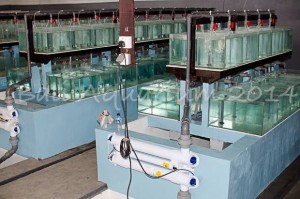It’s a fish eat fish world out there. Wild fishes face daunting lives in nature; everything in the ocean either wants to eat you or outcompete you for territory or mates. Collection for the aquarium is only the beginning of a hectic and stressful time in their lives. Once collected they’re held in a facility and purged (allowed time to expel waste) for a period of time prior to shipping. Then they’re bagged, boxed and shipped off to wholesalers around the world. Ripped from boxes and exposed to bright light after hours of travel in complete darkness, they’re acclimated to holding tanks at wholesalers. Fishes are then offered various foods and sold to retailers around the wholesalers’ country.
Most wholesalers have to move these fishes out within a week to remain profitable. Once purchased by a retailer, fish are once again bagged, boxed, and shipped to their new temporary home. Boxes are opened, bright lights are glaring, and a fish must start to think, ‘what in the hell is going on here!’. As with wholesalers, most retailers have to move a fish within a week in order to stay profitable. Remember that fish food, saltwater, and employees all cost money that adds to the final price. If a retailer’s main concern is to offer the most affordable prices in the area, even a week is a long time to hold onto a fish. Unfortunately for the average hobbyist, this leaves them with huge risk factors to deal with: Is this fish eating well? Does it have parasites, bacterial or fungal infections?

Conditioned Holacanthus clarionensis in retail display at MACNA 2014 in Denver. Credit: Austin Lefevre
One statistic that’s always stuck with me is “Internal worm infections are found in approximately 70 to 85% of tropical marine fish imported from the Philippines, Indonesia, Sri Lanka, Hawaii, the Caribbean, Australia, and the Red Sea.” (Bassleer, Gerald. Diseases in Marine Aquarium Fishes, page 74. 2004). Now how many average hobbyists are ready to treat for such things? Even know what to look for? An internal parasite takes a trained eye to spot symptoms, or you end up with a story that reads something like, “My fish was eating great but not gaining weight, then just up and died for no reason. I’m never buying a fish from XYZ again!” Unless the ailment is obvious upon arrival many issues won’t show symptoms within a week. At this point the wholesaler and retailer have already moved the fish into possession of a hobbyist. Are you ready? Still glad you saved 25% on that fish?
A good wholesaler is going to ensure their fishes are sourced from collectors who use sustainable practices. A great wholesaler is going to open the box from the exporter under dim, or red spectrum lights. A superb wholesaler is going to ensure the fish is eating prior to shipping to a retailer. This all adds to the cost of a fish.
A good retailer is going to pay a little more and purchase from the sustainable minded wholesaler. A great retailer is going to ensure fish are readily eating prepared foods easily offered by hobbyists. A superb retailer is going to keep the fish for more than a week and treat as necessary for any ailments, potentially even prophylactically. This all adds to the cost of a fish.

Collector Rufus Kimura holding Paracentropyge boylei and Centropyge narcosis after deep collection in Tahiti. Credit: John Hansen
Some fish are only found in remote areas far flung from the nearest airport. This means that a trained crew, boat(s), and holding equipment are necessary to go collect that fish. If we’re talking about truly deepwater fish which may be collected in excess of 400 feet (122 m), human lives are now at stake in order to collect a fish for your aquarium. Going this deep requires expensive rebreather equipment, not to mention the otherworldly expense of becoming trained and certified to use them. This all adds to the cost of a fish.
I have many friends in the industry who live around Los Angeles, the mecca of marine importation for the American hobbyist. There’s a street in L.A. with literally a dozen wholesalers spanning the road. Retailers in that area can go hand pick fish and have them acclimating at their store within an hour. No shipping required, no lengthy acclimation process for the retailers to endure. Hobbyists in that area will oftentimes see lower prices than anywhere else in the US. Now take a look at Billy Bob who owns a local fish store in eastern Kentucky, and doesn’t have the same access to wholesalers. He’s forced to ship the fish in and acclimate after another plane ride. This all adds to the cost of a fish.
Now I’m not saying that you should always opt for a more expensive fish. Unfortunately there are retailers out there that will price gouge, it happens in every industry. What hobbyists need to be mindful of is the value of a fish. A well cared for and conditioned fish is worth more money. No one should have to purchase a fish several times to get one to live.
Next time you see a deal that’s too good to be true, it is. Avoid retailers who treat fish as a cut flower with a finite lifespan. Many fishes have the potential to live for decades in captivity provided the right care. It starts with sourcing the best fish possible. Do yourself a favor. Do the fish a favor. Respect the fish.













Ron Boyer
I love my flame prawn goby
Jeff EatonMojoreef Bendalli
I want 1 of these!!!!
They are like 1.5″ and almost $100 but let me know
FWIW the specimen pictured was just shy of 1/2″. Tiny little bugger.
I couldn’t agree anymore, albeit I am so concerned at the current state of “instant knowledge” of the new Facebook group trends where newbies are advising newbies (even though the information age has actually brought so much crucial marine biological information to us at the same time! Thanks for the article!